As cryptocurrency adoption continues to surge globally, so does the sophistication of fraud schemes targeting digital assets. In 2023 alone, cryptocurrency-related fraud resulted in losses exceeding $3.2 billion, highlighting the urgent need for advanced security solutions. Traditional rule-based detection systems are increasingly inadequate against evolving threats, creating a critical security gap in the crypto ecosystem. AI-powered cryptocurrency fraud detection represents the cutting edge of financial security technology, offering unprecedented capabilities to identify suspicious patterns, predict emerging threats, and protect digital assets in real-time.
How AI Detects Crypto Fraud
AI-powered cryptocurrency fraud detection systems leverage sophisticated algorithms and vast datasets to identify suspicious activities that would otherwise go unnoticed. Unlike traditional rule-based systems that rely on predefined parameters, AI solutions can adapt to new threats and evolve alongside fraudsters’ tactics.
AI systems analyze millions of transactions to identify suspicious patterns and anomalies in real-time
Machine Learning Models for Transaction Pattern Analysis
At the core of AI-powered cryptocurrency fraud detection are sophisticated machine learning models trained on vast datasets of both legitimate and fraudulent transactions. These systems employ various algorithms to establish baseline behaviors and identify deviations that may indicate fraud.
The most effective machine learning models for cryptocurrency fraud detection include:
- Supervised learning algorithms like Random Forest and XGBoost that classify transactions based on historical data
- Unsupervised learning techniques that detect anomalies without prior labeling
- Deep learning networks, particularly Long Short-Term Memory (LSTM) models, that excel at analyzing sequential transaction data
- Graph Neural Networks (GNNs) that map relationships between wallet addresses to identify suspicious networks
These models analyze numerous transaction features, including:
- Transaction velocity and frequency patterns
- Amount distributions and deviations
- Wallet age and transaction history
- Network connections between addresses
- Temporal patterns and time-of-day anomalies
- Gas fee variations and smart contract interactions
American Express implemented LSTM-based AI models and improved their fraud detection capabilities by 6%, while PayPal achieved a 10% improvement in real-time fraud detection through continuous AI monitoring. These real-world implementations demonstrate the tangible benefits of machine learning in financial security.
Real-time Anomaly Detection in Blockchain Networks
Blockchain transactions occur 24/7 across global networks, requiring constant vigilance against fraudulent activities. AI-powered systems excel at real-time monitoring, analyzing each transaction as it happens to identify potential threats before they cause damage.
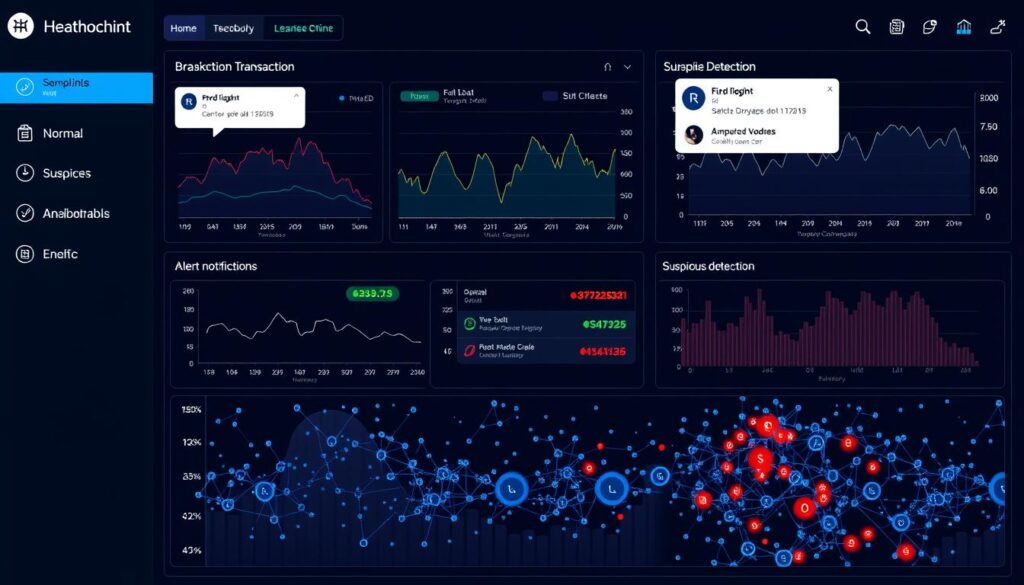
Real-time monitoring dashboards allow security teams to respond immediately to detected anomalies
Real-time anomaly detection systems employ several techniques:
“The combination of statistical modeling and machine learning enables cryptocurrency security systems to establish dynamic baselines of normal behavior and immediately flag transactions that deviate significantly from expected patterns.”
- Statistical modeling to establish baseline transaction patterns
- Dynamic thresholds that adjust based on market conditions and user behavior
- Behavioral biometrics that analyze how users interact with platforms
- Network analysis to identify suspicious connections between wallets
- Smart contract vulnerability scanning to prevent exploitation
Case Study: AI System Flagging a Sophisticated Phishing Scam
In early 2023, an AI-powered security system at a major cryptocurrency exchange detected an elaborate phishing operation targeting high-value wallet holders. The attack employed convincing emails impersonating the exchange’s support team and directed users to a fraudulent website that mimicked the exchange’s interface.
How the AI System Detected the Attack:
- Identified unusual login patterns from unfamiliar IP addresses
- Detected anomalous withdrawal requests that deviated from users’ historical behavior
- Recognized suspicious smart contract interactions attempting to drain funds
- Correlated multiple small withdrawals targeting the same external wallets
- Flagged unusual timing patterns occurring outside users’ typical active hours
The AI system’s intervention prevented an estimated $18.7 million in potential losses and identified the attackers’ wallet network, allowing for enhanced monitoring of related addresses.
Security Monitoring with AI
Beyond detecting fraud after it occurs, modern AI systems excel at proactive security monitoring, continuously analyzing blockchain data to identify potential threats before they materialize into actual attacks.
Predictive Analytics for Threat Prevention
Predictive analytics represents one of the most powerful applications of AI in cryptocurrency security. By analyzing historical attack patterns and current network behaviors, these systems can forecast potential vulnerabilities and emerging threats.
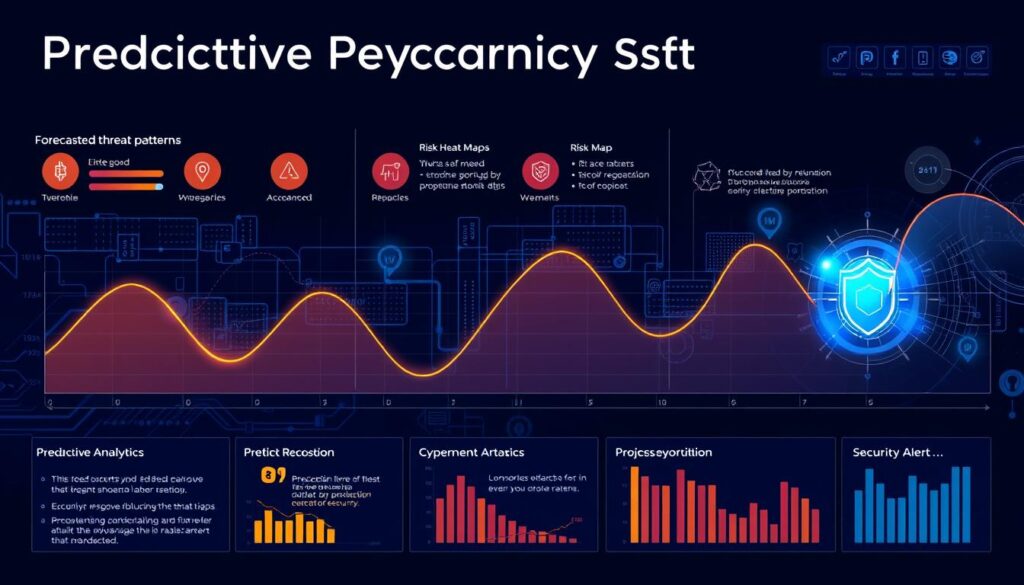
Predictive analytics systems forecast potential threats based on historical patterns and current network behavior
Key capabilities of predictive analytics in cryptocurrency security include:
Threat Pattern Recognition
AI systems analyze historical attack data to identify common patterns and signatures that precede fraudulent activities, allowing for early intervention.
Vulnerability Assessment
Machine learning models continuously scan smart contracts and protocols to identify potential security weaknesses before they can be exploited.
Risk Scoring
Advanced algorithms assign risk scores to transactions and addresses based on multiple factors, prioritizing security resources toward the highest-risk activities.
Predictive analytics has proven particularly effective against emerging threats like flash loan attacks and cross-chain vulnerabilities, where traditional security measures often fall short. By identifying the precursors to these attacks, AI systems can alert security teams to implement preventative measures before exploitation occurs.
Behavioral Biometrics to Authenticate Users
Beyond analyzing transaction data, AI-powered security systems employ behavioral biometrics to verify user identities based on their unique interaction patterns with cryptocurrency platforms.

Behavioral biometrics analyze unique user interaction patterns to verify identity and detect account takeovers
Behavioral biometric systems analyze numerous interaction factors:
- Typing rhythm and speed when entering passwords or addresses
- Mouse movement patterns and click behaviors
- Navigation habits within cryptocurrency platforms
- Transaction timing and frequency patterns
- Device handling characteristics on mobile applications
- Session duration and activity patterns
These systems establish a behavioral baseline for each user and continuously compare current interactions against this profile. When significant deviations occur—such as during an account takeover attempt—the system can trigger additional authentication requirements or temporarily restrict high-risk actions.
Key Insight: Behavioral biometrics provide a frictionless security layer that operates invisibly to legitimate users while creating significant barriers for fraudsters, even when they possess stolen credentials.
Integration with Decentralized Exchanges (DEXs) and Wallets
The integration of AI security systems with decentralized exchanges and cryptocurrency wallets represents a critical advancement in protecting users across the entire transaction lifecycle.
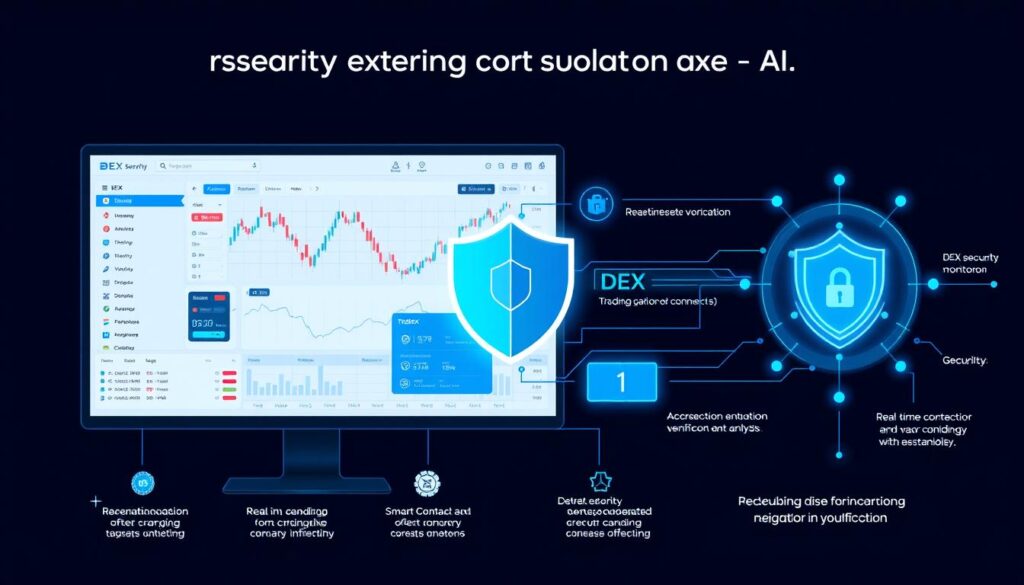
AI security systems integrate directly with DEXs and wallets to provide real-time protection
Modern integration approaches include:
DEX Security Features:
- Pre-transaction risk assessment that evaluates potential trades
- Smart contract vulnerability scanning before interaction
- Liquidity pool monitoring to detect manipulation attempts
- Front-running detection and prevention mechanisms
- Rug pull identification based on token and developer behavior patterns
Wallet Protection Capabilities:
- Destination address verification and risk scoring
- Suspicious transaction alerts based on amount and recipient
- Phishing site detection when connecting wallets
- Approval monitoring to prevent malicious contract authorizations
- Multi-signature recommendation for high-value transactions
These integrations provide comprehensive protection throughout the user journey, from wallet creation to trading and long-term asset storage. By embedding AI security directly into the tools users interact with daily, the cryptocurrency ecosystem can significantly reduce successful fraud attempts.
Benefits of AI-Driven Systems
The implementation of AI-powered cryptocurrency fraud detection systems offers numerous advantages over traditional security approaches, delivering tangible improvements in detection accuracy, operational efficiency, and adaptability to new threats.
Reduced False Positives Compared to Rule-Based Systems
One of the most significant challenges in fraud detection is balancing security with user experience. Traditional rule-based systems often generate excessive false positives, flagging legitimate transactions as suspicious and creating unnecessary friction for users.
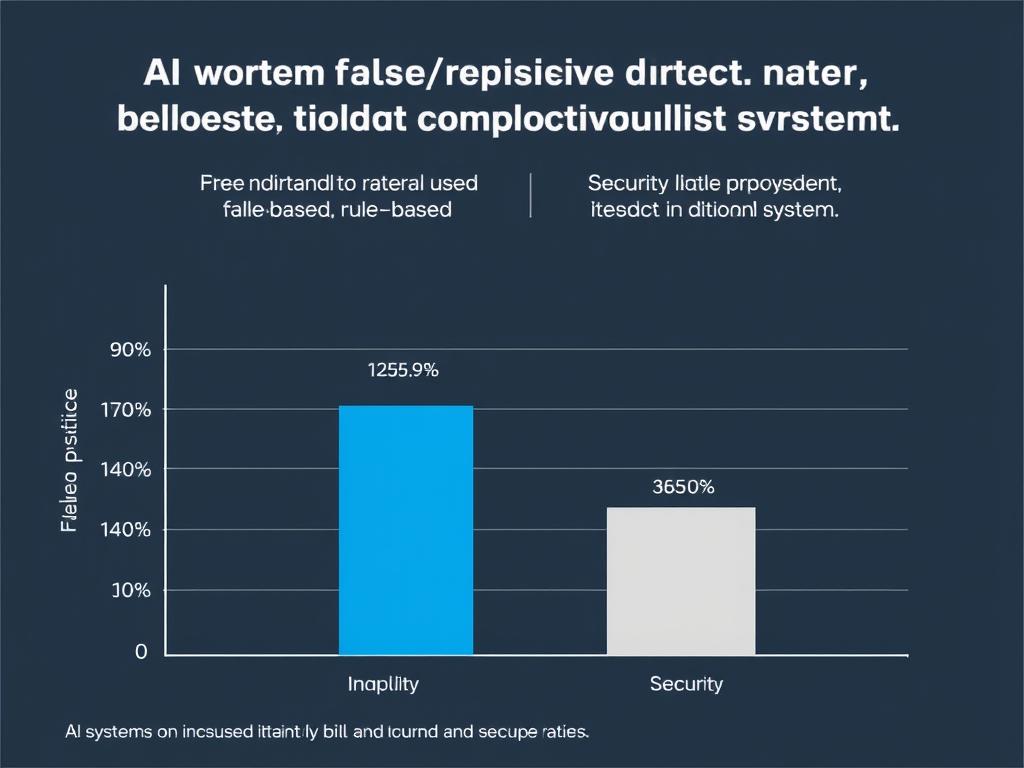
AI-powered systems significantly reduce false positive rates while maintaining high security standards
AI-driven systems address this challenge through:
- Contextual analysis that considers multiple factors before flagging transactions
- User-specific risk profiles that adapt to individual behavior patterns
- Confidence scoring that prioritizes high-probability threats
- Continuous learning from feedback loops when alerts are resolved
- Multi-factor evaluation that reduces single-point decision errors
“Our implementation of machine learning models reduced false positives by 73% while simultaneously improving fraud detection rates by 27%. This dual improvement transformed both our security posture and customer satisfaction metrics.”
The reduction in false positives delivers substantial benefits beyond improved security, including decreased operational costs, enhanced customer satisfaction, and more efficient allocation of security resources toward genuine threats.
Scalability for High-Volume Crypto Transactions
The cryptocurrency ecosystem processes millions of transactions daily across multiple blockchains, creating enormous challenges for security monitoring. AI-powered systems offer unparalleled scalability to handle this volume without compromising detection capabilities.

AI systems can scale to process millions of transactions across multiple blockchains simultaneously
Key scalability advantages include:
Distributed Processing
AI systems leverage cloud infrastructure to distribute computational loads across multiple nodes, enabling linear scaling as transaction volumes increase.
Efficient Resource Allocation
Machine learning models dynamically allocate computing resources based on risk levels, focusing intensive analysis on suspicious transactions while processing routine activities efficiently.
Cross-Chain Monitoring
Advanced AI architectures can simultaneously monitor multiple blockchains and layer-2 solutions, providing comprehensive security across the entire cryptocurrency ecosystem.
This scalability is particularly crucial during market volatility periods when transaction volumes can surge dramatically. While traditional systems often experience degraded performance or increased false positives under high loads, AI-powered solutions maintain consistent accuracy regardless of volume fluctuations.
Adaptive Learning to Counter Evolving Fraud Tactics
Cryptocurrency fraudsters continuously evolve their techniques to circumvent security measures. AI-powered systems counter this through adaptive learning capabilities that identify and respond to new attack vectors without requiring manual updates.
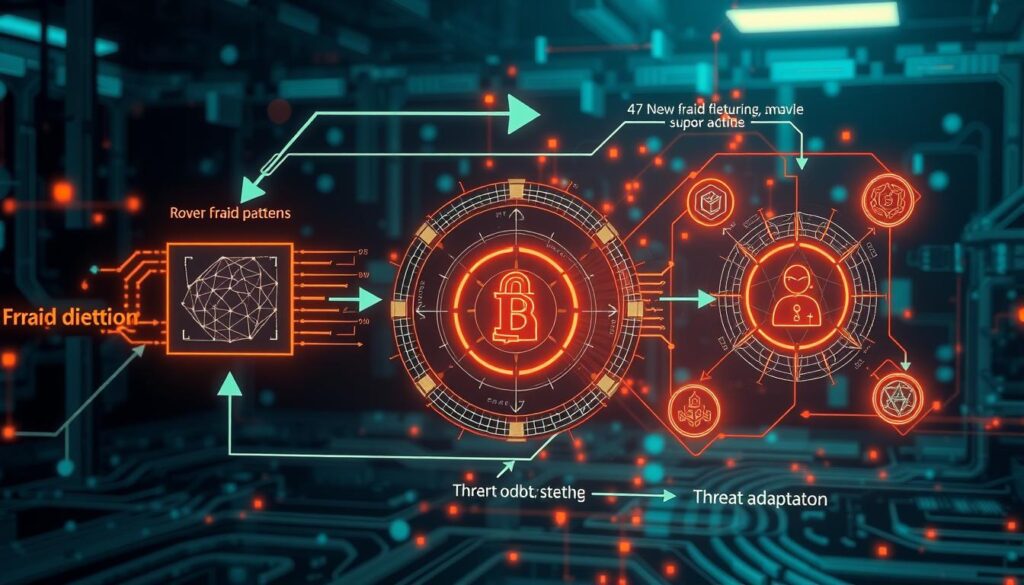
Adaptive learning enables AI systems to identify and counter new fraud techniques as they emerge
The adaptive learning process involves several sophisticated mechanisms:
- Unsupervised anomaly detection identifies previously unseen patterns that deviate from normal behavior
- Transfer learning applies knowledge from known fraud types to recognize variations and new implementations
- Federated learning enables security improvements across platforms while preserving data privacy
- Adversarial training simulates potential attack vectors to strengthen detection capabilities
- Continuous model retraining incorporates new data to maintain relevance against emerging threats
This adaptive capability creates a significant advantage in the ongoing security arms race, allowing protection systems to evolve alongside threats rather than perpetually playing catch-up through manual updates and rule modifications.
Challenges and Limitations
Despite their considerable advantages, AI-powered cryptocurrency fraud detection systems face several significant challenges that must be addressed to maximize their effectiveness and adoption.
Data Privacy Concerns in Decentralized Environments
The fundamental tension between comprehensive security monitoring and privacy preservation represents one of the most significant challenges for AI-powered security in cryptocurrency environments.

Privacy-preserving AI techniques enable security monitoring while protecting sensitive user data
Key privacy challenges include:
Privacy-Preserving Approaches
- Federated learning that keeps sensitive data on local devices
- Homomorphic encryption enabling analysis of encrypted data
- Zero-knowledge proofs verifying information without revealing it
- Differential privacy adding calculated noise to protect individual data
- Secure multi-party computation distributing analysis across entities
Remaining Challenges
- Computational overhead of privacy-preserving techniques
- Reduced model accuracy when working with limited data
- Regulatory uncertainty regarding privacy requirements
- Balancing transparency with confidentiality
- Cross-border data protection compliance
The cryptocurrency community’s strong emphasis on privacy and self-sovereignty creates additional implementation challenges. Solutions must demonstrate clear security benefits while respecting these core values to achieve widespread adoption.
Privacy-Preserving Innovation: Recent advances in privacy-enhancing technologies (PETs) are enabling more effective balancing of security and privacy concerns. These include trusted execution environments, confidential computing platforms, and blockchain-native privacy solutions that allow for security monitoring without compromising user anonymity.
Over-reliance on AI and Potential Adversarial Attacks
As cryptocurrency platforms increasingly depend on AI for security, they must also address the vulnerabilities inherent to these systems, particularly their susceptibility to adversarial attacks specifically designed to manipulate AI decision-making.
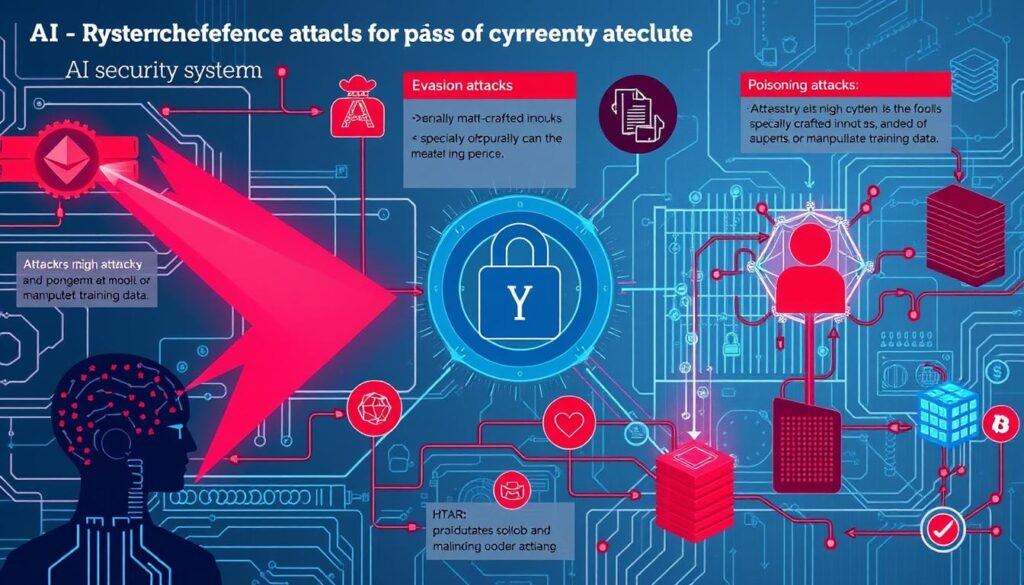
Adversarial attacks attempt to manipulate AI systems by exploiting their learning mechanisms
Common adversarial attack vectors include:
- Evasion attacks that modify fraudulent transactions to appear legitimate
- Poisoning attacks that contaminate training data to weaken detection capabilities
- Model extraction attempts to reverse-engineer security algorithms
- Membership inference attacks that determine if specific transactions were used in training
- Transferability exploitation leveraging weaknesses across different AI systems
Defending against these sophisticated attacks requires multi-layered security approaches:
| Defense Strategy | Implementation Approach | Effectiveness |
| Adversarial Training | Incorporating adversarial examples in model training | High for known attack vectors |
| Ensemble Methods | Using multiple models with different architectures | Very high for diverse attacks |
| Robust Optimization | Designing models to minimize maximum loss under perturbations | Moderate to high |
| Input Sanitization | Preprocessing inputs to remove potential adversarial components | Moderate for simple attacks |
| Human-in-the-Loop | Combining AI with human oversight for critical decisions | Very high but less scalable |
The most effective security architectures avoid over-reliance on any single AI system, instead implementing defense-in-depth strategies that combine multiple detection methods with traditional security controls and human oversight for high-risk activities.
Critical Consideration: Organizations implementing AI-powered security must develop contingency plans for potential AI system failures or compromises. These should include fallback detection mechanisms, isolation procedures for affected systems, and rapid response protocols to minimize potential damage.
Future Trends in AI-Powered Crypto Security
The rapidly evolving landscape of both cryptocurrency and artificial intelligence is driving several emerging trends that will shape the future of digital asset security.
AI Combined with Quantum-Resistant Encryption
As quantum computing advances threaten to undermine current cryptographic standards, the integration of AI with quantum-resistant encryption represents a critical frontier in cryptocurrency security.

Next-generation security will combine AI detection with quantum-resistant cryptographic protocols
Key developments in this area include:
- AI-optimized implementation of lattice-based cryptography
- Machine learning for anomaly detection in post-quantum cryptographic systems
- Quantum-resistant digital signatures secured by AI verification layers
- Adaptive security protocols that respond to quantum computing advances
- Hybrid classical-quantum security models enhanced by predictive AI
These integrated approaches will be essential as quantum computing continues to advance, potentially threatening the cryptographic foundations of blockchain technology. By combining AI-powered threat detection with quantum-resistant encryption, cryptocurrency platforms can maintain security even as computational paradigms shift dramatically.
Cross-Chain Monitoring Interoperability
As the cryptocurrency ecosystem becomes increasingly fragmented across multiple blockchains and layer-2 solutions, comprehensive security requires sophisticated cross-chain monitoring capabilities.

Cross-chain monitoring systems provide unified security visibility across the fragmented cryptocurrency ecosystem
Emerging interoperability solutions focus on:
Unified Threat Intelligence
AI systems that aggregate and correlate security data across multiple blockchains to identify sophisticated attacks spanning different networks.
Cross-Chain Identity Verification
Advanced behavioral analytics that track entity patterns across blockchains to maintain consistent security profiles regardless of network.
Coordinated Response Mechanisms
Integrated security frameworks that enable synchronized protective actions across multiple platforms when threats are detected.
These cross-chain capabilities are particularly important for detecting sophisticated attacks that deliberately fragment their activities across multiple networks to evade detection. Only by maintaining comprehensive visibility across the entire ecosystem can security systems effectively protect against these advanced threats.
How will AI security systems adapt to increasing blockchain privacy features?
As privacy-focused cryptocurrencies and privacy layers on existing blockchains become more prevalent, AI security systems will evolve to focus more on metadata analysis, pattern recognition at entry and exit points, and behavioral analytics rather than direct transaction content inspection. Advanced systems will leverage zero-knowledge technology to verify security properties without accessing protected transaction details, maintaining security while respecting enhanced privacy.
What role will decentralized AI play in future cryptocurrency security?
Decentralized AI represents a promising frontier for cryptocurrency security, aligning philosophically with blockchain’s distributed nature. These systems will distribute both computation and governance across networks, reducing central points of failure while enabling collaborative security models. Federated learning approaches will allow security insights to be shared without exposing sensitive data, while blockchain-based AI marketplaces will accelerate innovation by connecting security algorithm developers with platforms needing protection.
How will regulatory developments impact AI-powered cryptocurrency security?
Evolving regulations will significantly shape AI security implementations, particularly regarding data usage, model transparency, and cross-border operations. Future systems will likely incorporate regulatory compliance as a core design principle, with configurable frameworks that can adapt to different jurisdictional requirements. AI explainability features will become increasingly important to satisfy regulatory demands for transparency in automated security decisions, especially for systems that can restrict user transactions or freeze assets.

The future of cryptocurrency security will integrate multiple AI technologies with blockchain-native security mechanisms
Conclusion
AI-powered cryptocurrency fraud detection and security monitoring systems represent a transformative advancement in protecting digital assets from increasingly sophisticated threats. By leveraging machine learning, real-time anomaly detection, and predictive analytics, these systems provide capabilities far beyond traditional security approaches.
The integration of AI with cryptocurrency security delivers multiple critical advantages:
- Dramatically improved detection of fraudulent activities through pattern recognition and behavioral analysis
- Significant reduction in false positives, enhancing both security effectiveness and user experience
- Unprecedented scalability to handle the massive transaction volumes of global cryptocurrency networks
- Adaptive learning capabilities that evolve alongside emerging threats without requiring manual updates
- Proactive security through predictive analytics that identify potential vulnerabilities before exploitation
While challenges remain—particularly regarding data privacy, adversarial attacks, and cross-chain interoperability—ongoing innovations continue to address these limitations. The future integration of AI with quantum-resistant encryption and decentralized security frameworks promises even more robust protection for the cryptocurrency ecosystem.
For cryptocurrency exchanges, wallet providers, and financial institutions operating in the digital asset space, implementing AI-powered security is no longer optional but essential. As fraud techniques grow more sophisticated and transaction volumes increase, only advanced AI systems can provide the comprehensive protection necessary to safeguard assets and maintain user trust.


No comments yet